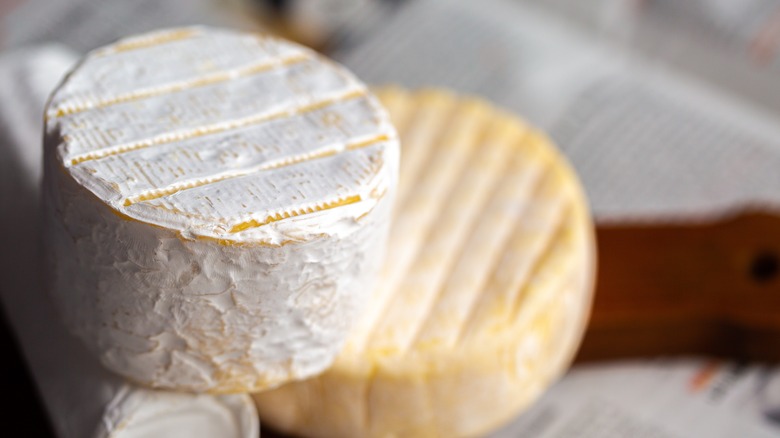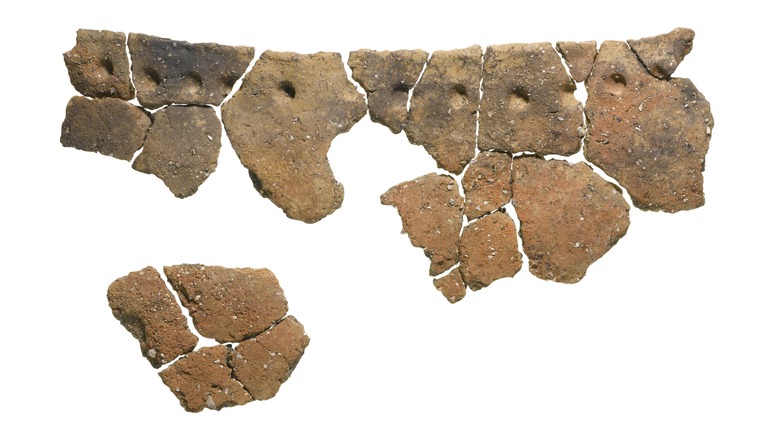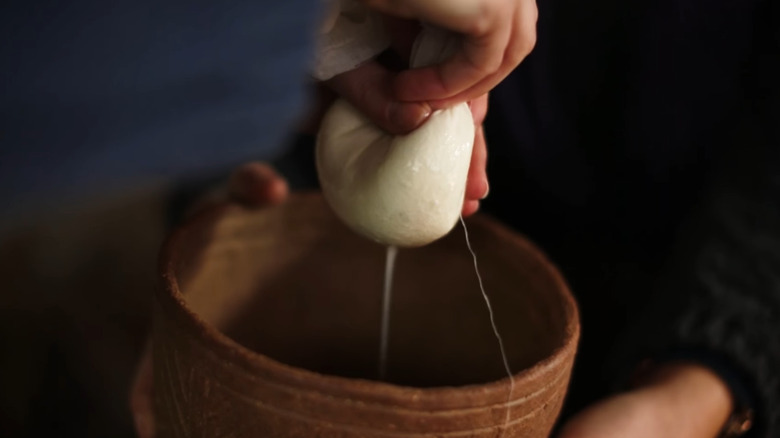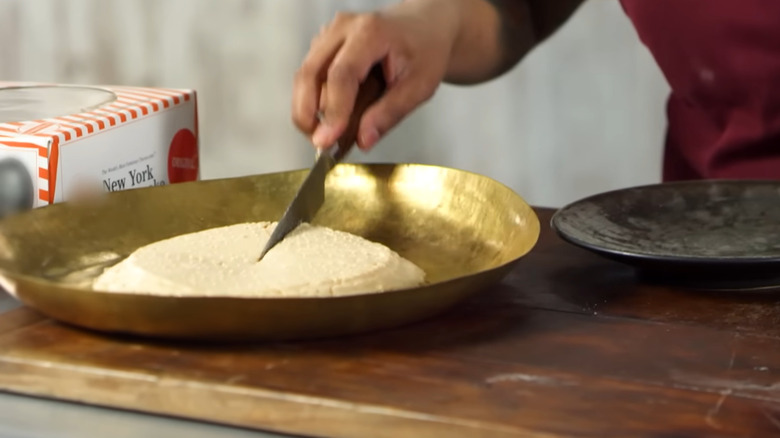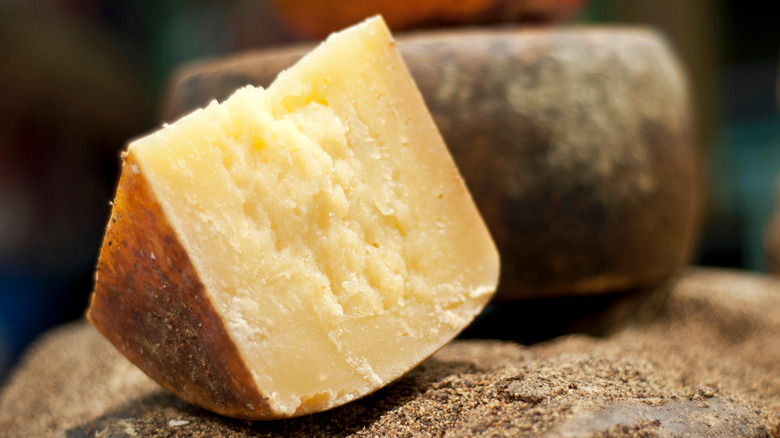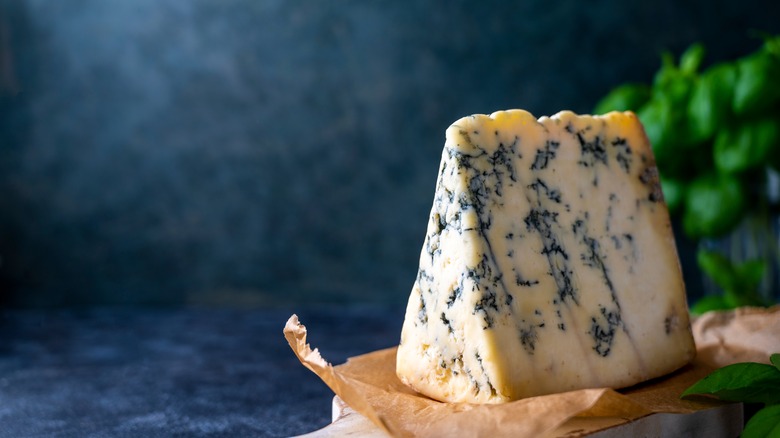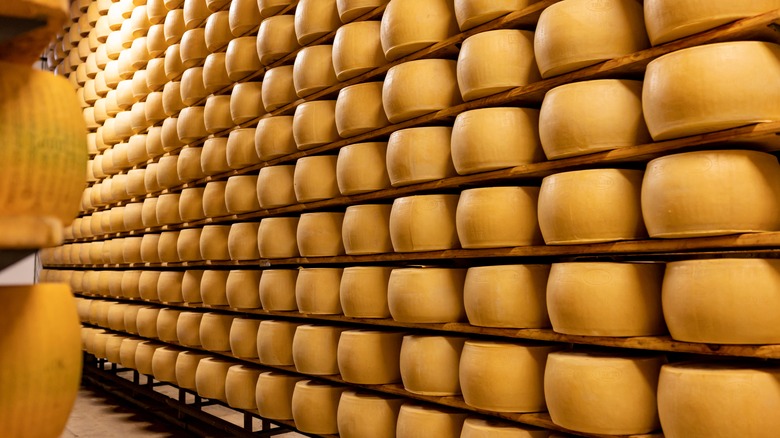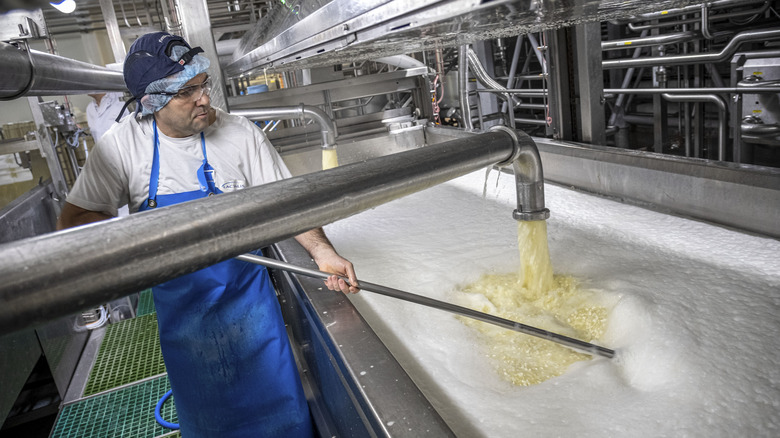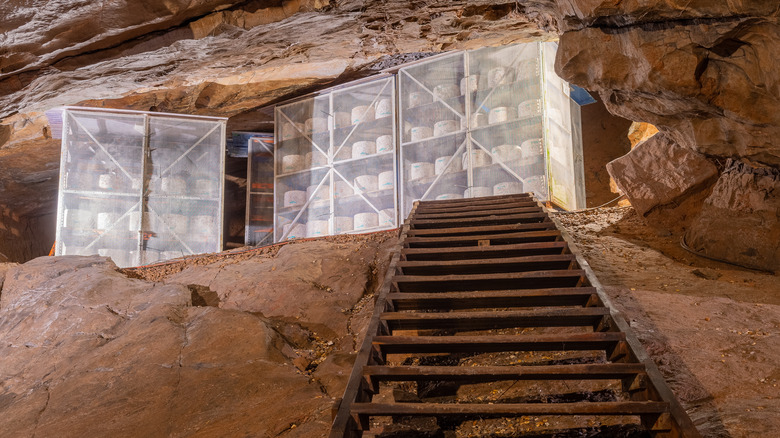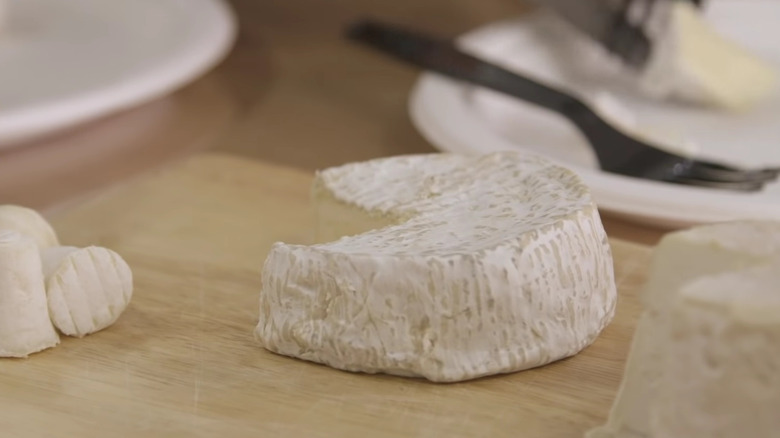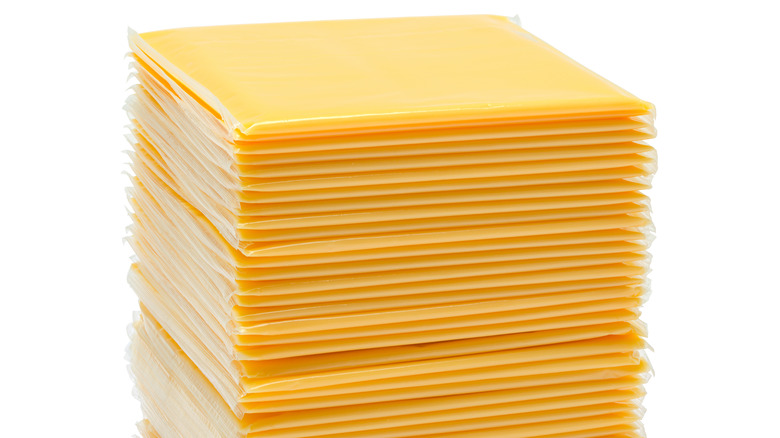The Ancient History Of Cheese
Cheese is a big deal. Just take a look at the absolutely staggering number of cheeses available to the modern shopper around the world. According to Wisconsin Cheese, there are nearly 2,000 known cheese types on the global market today. This vast range of products is only the tip of the iceberg, as there is also a multitude of cheese making techniques, base ingredients, and aging processes involved. The diversity of today's cheeses is truly staggering, ranging from mold-inoculated blues to rind-washed pungent cheeses, and everything in between.
Aside from building a global market that's worth a staggering $77.6 billion (per Statista), cheese has become something of a foodie phenomenon, inspiring adoration from thousands of passionate cheese professionals and hungry consumers, as per The New York Times.
For all that popularity, cheese was not always this bright cacophony of flavors, textures, and aromas. For millennia, cheese making remained a mysterious process that humans wielded little control over. Yet, through the diligent practice of some of the world's greatest ancient cultures, humans have raised cheese making from a practice of subsistence to an incredible sensory art form.
The first cheese ever made may have used acid and heat
The history of cheese making is irrevocably intertwined with the advent of farming. As per FarmingUK, this practice began in an area known as the Fertile Crescent — which includes modern Middle Eastern countries such as Syria, Jordan, and Iraq — during the Neolithic Age, around 11,000 years ago. Aside from growing plants, farming involved the raising of livestock such as cows, sheep, and goats that lactate. Yet milk from farm animals was useless to the majority of humans during these times, as nearly all of humanity was lactose intolerant after moving past infanthood, as per Cheese Grotto.
While animal milk was used to feed children, the continually improving practice of pottery made storing excess milk possible. It is thought that keeping leftover milk in clay vessels led to the accidental creation of the world's first cheese. The heat of nearby fires or the presence of lactic acid bacteria could have caused the milk to coagulate, splitting it into an edible semisolid curd and liquid whey (via Cheese).
An alternative cheesemaking method, where milk is coagulated by an enzyme known as rennet, could also have been uncovered by mistake. Rennet is produced in a calve's stomach, so rennet-derived cheese likely came about when someone stored milk in empty animal stomachs, which are naturally rich in the enzymes (via The Courtyard Dairy).
Cheese making allowed people to circumnavigate lactose intolerance
Whether it's been coagulated by heat, acid, or rennet, cheese separates into liquid whey and solid or semi-solid cheese curds. The curds can be eaten fresh or further processed and aged to increase their shelf life (via ACS). The ability to separate the curd from the whey was of particular importance to ancient communities. That's because the whey is where the vast majority of lactose is found, as per Healthline. This meant that the newly-formed cheese contained considerably lower levels of this sugar than in milk. Lactose-intolerant adults could enjoy this new product with a greatly lessened fear of becoming ill.
The hypothesis that cheese may have offered a new food product to lactose-intolerant humans is becoming increasingly supported, thanks to the discovery of evidence such as neolithic cheese processing tools (via National Geographic) and the presence of dairy proteins embedded in the dental plaque of Stone Age human teeth. Dr. Sophy Charlton, a researcher at Oxford University, told The Daily Mirror that this points to neolithic people purposefully removing lactose via cheesemaking, all to make these nutritious products digestible by more people.
Cheese was popular in ancient Egypt
Before the discovery of 8,000 to 7,000-year-old pottery shards from neolithic cheese making tools (via Discover), the main evidence for ancient cheese making came from artwork. Given their predilection for carving hieroglyphics everywhere, it should come as little surprise that some of the oldest images depicting cheese making came from ancient Egypt. As Smithsonian Magazine reports, these dairy-processing murals often decorated the walls of ancient Egyptian tombs and have been dated to around 4,000 years old.
A 2018 discovery shed further light on ancient Egyptian cheesemaking. When examining the tomb of an official known as Ptahmes, scientists found remnants of an over 3,000-year-old cheese, as per TIME. According to The New York Times, this would have been a fresh, spreadable cheese, potentially one made through acid and heat coagulation. However, other finds and records indicate that this was not the only type of cheese consumed in ancient Egypt. Further archaeological discoveries have revealed that blocks of cheese, very similar to modern-day halloumi, were enjoyed by Egyptians over 2,500 years ago, according to a press release from Egypt's Ministry of Tourism and Antiquities.
Cheesecake was invented in ancient Greece
As reported in the journal Gastronomica, cheese wasn't just a product in ancient Greece, but also an ingredient in more complicated dishes. Consider the invention of a dessert that has remained extremely popular to this day: cheesecake. According to the Greek Reporter, this initial iteration of cheesecake was simple and was made from a mixture of cheese, honey, and flour. As per Greek City Times, this baked delicacy was served to athletes as an energy-boosting food at the world's first Olympic Games, which took place in 776 BCE.
Ancient Greek cheese making is not limited to cakes. Real Greek Feta reports that its namesake cheese was invented in ancient times, a fact attested to by the cheese's inclusion in the epic poem "The Odyssey", which was written in the 8th or 7th centuries BCE. Mythology includes a story that cheesemaking was taught to the minor god Aristaeus by the nymphs (per GreekMythology.com). Furthermore, milk (and, by extension, milk products like cheese) was deemed sacred because the chief god Zeus was said to have been raised on goat's milk.
The Roman Empire transformed cheese making
While other civilizations saw the cheese making process as a culinary chore, ancient Romans were among the first people to elevate it into an art. This was largely helped by the increased use of rennet to coagulate milk instead of a combination of acid and heat. We know the Romans used rennet because the method was recorded in the "De Re Rustica" series of books examining Roman agriculture, written by Columella in the 1st century CE (via Consorzio per la Tutela del Formaggio Pecorino Romano).
As reported by Atamad, rennet coagulates milk quickly and helps remove moisture from the finished cheese, preventing spoilage. This ability, along with other preservation processes such as smoking, began to set Roman cheese apart. As Forbes reports, this ingenuity allowed the ancient Romans to invent numerous types of cheese. One such cheese was Pecorino Romano. Made in the same way for over 2,000 years, Pecorino Romano formed an important part of ancient Roman cuisine. It was used for practically everything, from filling soldier's rations to gracing the spreads of elegant, extravagant banquets. The processes used to make this particular cheese can get tricky since it is aged for at least five months (per Italy Magazine), stored in specialist rooms, and "sweated" with salt. That complexity reveals just how advanced ancient Roman cheese making was for its time.
Blue cheese was invented in Europe
As reported in the Encyclopedia of Food Microbiology, a mold-infused blue cheese requires low temperatures and high humidity to mature. With a more temperate environment than other regions, Central and Western Europe provided the perfect climate for these new, startlingly different cheeses to become popular.
New evidence suggests that blue cheese was made in the mining towns of Austria as far back as the Iron Age, as per Current Biology. According to archaeologist Kerstin Kowarik, salt miners in the region appear to have innovated complicated fermentation techniques that were so effective they are still in use today (via Smithsonian Magazine).
While creating moldy cheese is definitely not a new phenomenon, blue cheese has captivated people for generations thanks to its striking appearance and powerful flavor. During the time of the ancient Romans, the variety of blue cheese that was in vogue was Roquefort, a tangy blue cheese that is still famous today, as per Vice. According to the South China Morning Post, Roquefort was enjoyed by noted ancient Romans including Pliny the Elder and even Julius Caesar.
Medieval monks crafted some of the world's most popular cheese
Throughout history, monks have distinguished themselves as some of the world's foremost culinary innovators of incredible products such as orange wine (via Identitā Golose), beer (per Tennessee Register), and cheese — particularly washed rind cheese. As explained by VinePair, this cheese is made by washing the rind of a maturing cheese with alcohol. This changes the bacteria that is present on the exterior and ultimately makes big differences in the appearance, aroma, and taste of the final cheese. Some of the most popular washed rind cheeses you can find today include Beaufort, Reblochon, and of course, the colorfully-named Stinking Bishop.
We shouldn't just thank monks for smelly cheeses, however. As reported by Musco Food Corporation, France's most famous cheese, brie, was invented by monks during the 7th century CE. However, monks' greatest contribution to the world of cheese comes from Italy in the form of Parmigiano Reggiano. As Parmigiano Reggiano reports, it was first invented by Benedictine and Cistercian monks in the 12th century. This cheese has since gone on to achieve near-mythical status and is prized by chefs all over the world including Mike Pirolo, who called it "the king of all cheeses" for its balance of flavor, texture, and acidity (via Forbes).
Cheese production changed during the Industrial Revolution
Beginning in Britain during the 17th century, the Industrial Revolution saw previously small-scale, artisanal activities become increasingly mechanized thanks to the construction of factories, regulated working hours, and new technology (via Britannica). As with all food production processes, industrialization changed the nature of cheese forever. The British drew inspiration from the United States, where specialist cheese factories were set up as early as 1851. These purpose-built factories were specially designed to house large equipment and produce vast quantities of cheese. However, it took until the mid-19th century for industrially-made cheese to become the norm in Britain, as per Enterprise and Society.
As reported by Cheese Grotto, the increased production of cheese meant that prices plummeted. This, along with the combined economic pressures of the Great Depression and two world wars, led to the development of cheap, processed cheese. Yet, manufacturer's prioritized lower prices and extended shelf lives to the detriment of quality. This led America into a period dominated by cheap, unhealthy, and bland cheese. Fortunately, the tide is beginning to turn in the artisans' favor. As The Atlantic reports, that's thanks to the increased awareness surrounding the health and environmental impacts associated with large-scale, industrial farming practices.
Britain has a long cheese making history
According to The Guardian, there are currently over 700 varieties of cheese that are made in the United Kingdom today. This abundance is built upon a solid base of historic, high-quality cheeses, including famous varieties like Gloucester, cheddar, and Wensleydale. These cheeses became famous in England around the 15th century, with cheddar, in particular, being met with acclaim. According to Paul Kindstedt, a professor of food science, the high-quality cheeses drew in rich city-dwellers from London, who visited the area and helped boost the reputation of cheese from Cheddar, England (via BBC).
Yet, the nation's cheese scene has not always been so healthy. Rather, it suffered from the intense industrialization of cheese in other competitive markets, especially those in the United States and Central Europe. Ironically, it was cheddar, one of Britain's most popular cheeses, that almost led to the industry's downfall. The mass production of American Cheddar almost obliterated the U.K.'s own producers, as per The Guardian. Fortunately, British artisanal cheese is booming once again with the number of varieties and sales growing exponentially (via Speciality Food).
East Asia has a complicated cheese history
Cheese is not a common feature of most East Asian dishes. Instead, any protein that wasn't meat or fish was most likely to come via soy, an ingredient that has remained an integral part of East Asian diets in forms like tofu or tempeh (per SNI Global). However, the dominance of soy does not mean that cheese has gone completely unenjoyed in East Asia. In fact, the opposite is true. According to Miranda Brown, a professor at the University of Michigan, people in what's now China have been making cheeses for a very long time, usually relying on yogurt or acid instead of rennet. "I suspect that all of these traditions came to China in the medieval period from the outside world — potentially from Mongolia or even the Persian areas of Central Asia," she said (via South China Morning Post).
According to Slate, the smaller appetite for cheese in East Asia is due to several factors. First, over 90% of adult East Asians are purported to be lactose intolerant which may lead to some gastrointestinal issues when eating cheese, as per DSM. Furthermore, cheese has long been negatively associated with nomadic tribes that were historically seen as uncivilized barbarians. Finally, East Asian people often report a dislike of the greasy texture of some cheeses, although this might change given the increasing factor of globalization when it comes to everyone's diets.
American cheese was inspired by Europe
It is a fact that the practice of raising dairy animals — and consequently cheese making — proliferated across all of the Americas because of colonialism. In fact, Sentient Media reports that cattle farming directly contributed to the colonial agenda by transforming the indigenous environment into one that more closely resembled what settlers remembers of Europe. As such, it is unsurprising that the cheese made in America is closely tied to European cheeses and cheddar cheese in particular, according to cheesemonger Gordon Edgar (via The Splendid Table).
Today, American cheese is carving its own identity, breaking away from the European precedent and its own processed history. Truly American cheeses include Colby, a moist, semi-hard variety with low acidity, as per Wisconsin Cheeseman. Other American-made cheeses such as Bay Blue and Reading draw on European classics while supercharging them with an undoubtedly American twist, as per VinePair.
Today, cheese is a globally produced commodity
As the longest-inhabited continent, Africa has a rich culinary history when it comes to dairy. Proof of this long practice, especially when it comes to cheese, has been discovered by archaeologists digging deep into history. As Max-Planck-Gesellschaft highlights, the consumption of milk-based products began on the continent over 6,000 years ago, although many people in these ancient African civilizations were probably lactose intolerant. This would suggest that, much like what may have been happening in Europe, people in Africa relied on fermentation to reduce lactose and create products like cheese. Even though lactose intolerance is more likely to hit people of African and Asian descent (via Cornell University), African countries like the Democratic Republic of Congo are becoming renowned producers of excellent cheese, as reported by BBC.
Across the Atlantic Ocean, cheese production is also becoming popular in South America. Traditionally, cheese produced in Latin America has been fresh, crumbly cheeses like panela (via Dairy Foods). However, producers across the continent are creating cheeses that break this mold such as cotija from Mexico, which is a hard, aged cheese similar to Parmigiano Reggiano (via Culture). When combined with Latin America's growing appetite for cheeses of new and varying textures and flavors (per Food Navigator), this budding industry has the potential to be extremely exciting.
